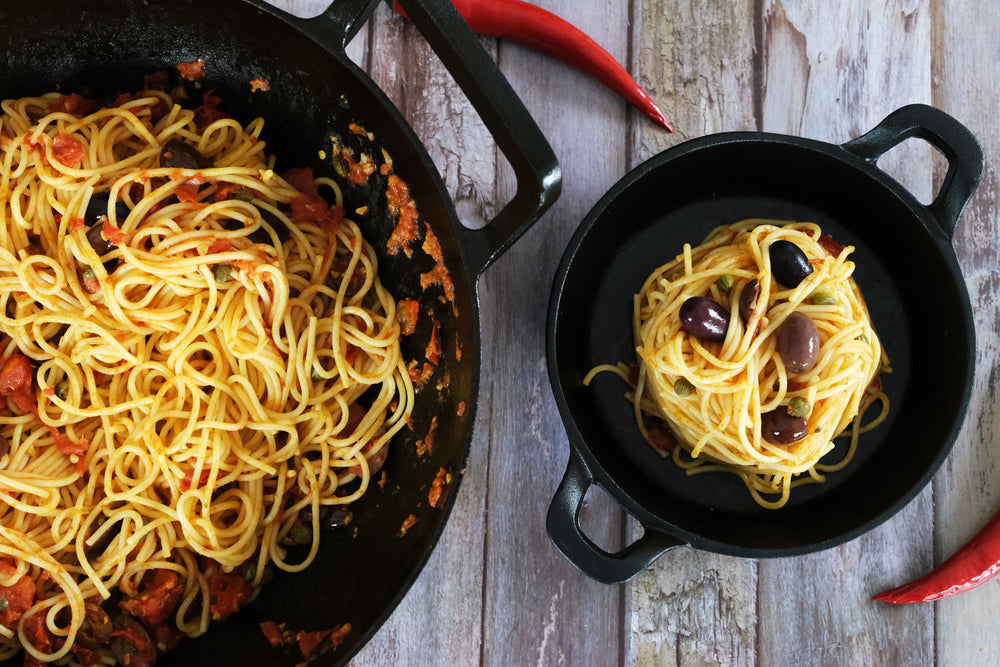Exploring Global Flavors: Part 5 - More Essential Spices for Your Kitchen

Dive into the rich world of global spices with this new collection of flavorful essentials. From tangy tamarind to the aromatic complexity of mahlab, these spices each tell a story of culture, history, and culinary tradition — and can elevate your cooking to exciting new heights.
This article is the fifth installment in our Exploring Global Flavors series, which has already taken readers through dozens of unique spices from around the world. If you missed the earlier parts, you can explore them here:
Now, let’s meet the next set of spices ready to inspire your cooking.
1. Tamarind
What It Is:
Tamarind is the fruit of the Tamarindus indica tree, native to tropical Africa but now widely grown across South Asia, the Caribbean, Latin America, and the Middle East. The pod contains sticky, tangy pulp surrounding seeds.
Geography & History:
Believed to have originated in tropical Africa, tamarind spread through trade routes to India and Southeast Asia over centuries. It’s been used in cooking and traditional medicine for thousands of years, prized especially in Indian, Thai, Middle Eastern, and Mexican cuisines.
Flavor Profile:
Tangy and sour with subtle sweetness and a fruity depth.
Common Uses:
-
Pad Thai sauce
-
Indian chutneys and curries
-
Mexican agua fresca and sauces
-
Middle Eastern stews and marinades
Tip:
Use tamarind paste or soaked tamarind pulp for easy cooking. Balance its sourness with sweeteners like jaggery or honey.
Nutrients:
Rich in tartaric acid, antioxidants, vitamin C, and B vitamins.
Health Benefits:
Aids digestion, supports heart health, and has anti-inflammatory properties.



2. Asafoetida (Hing)
What It Is:
A gum resin—a sticky, aromatic plant exudate composed of water-soluble gums and oil-based resins—harvested from the roots of Ferula plants native to regions like Iran, Afghanistan, and Central Asia. Collected by making incisions in the root, the milky sap hardens into pungent lumps.
Geography & History:
Hing’s story stretches back to ancient Persia, where it was prized in kitchens and traditional medicine for its bold flavor and digestive benefits. It reached Europe through Alexander the Great’s expeditions and appeared in Jewish, Islamic, and Ayurvedic texts as both a culinary staple and a remedy.
Flavor Profile:
Raw hing emits an extremely pungent aroma—often compared to boiled eggs or sulfur—earning it the nickname “devil’s dung” from early European traders who were shocked by its smell. However, when cooked, it transforms into a savory, leek-like flavor that enriches dishes with deep, umami-like complexity.
Common Uses:
-
Tempered in oil or ghee at the start of cooking to mellow its sharpness.
-
Essential in South Indian sambar, rasam, and many vegetarian dishes, particularly in Jain cuisine where onion and garlic are avoided.
-
Used in pickles, spice blends like panch phoron and chaat masala.
-
Adds depth to Persian soups and Afghan dumpling fillings.
Tip:
-
Heat a small pinch in oil or ghee before adding other ingredients to unlock its aroma.
-
Store in an airtight container, often double-sealed, to prevent the smell from permeating other spices.
-
Use sparingly—a little goes a long way.
Cultural Resonance:
Hing is celebrated in Indian homes as “the spice that makes food taste Indian,” with its aroma often evoking memories of family kitchens. In folklore, it’s even credited with curing digestive troubles in both people and animals.
Nutrients & Health Benefits:
Contains sulfur compounds with potential digestive, antimicrobial, antispasmodic, and anti-inflammatory properties. Traditionally used to ease bloating, aid respiratory function, and stimulate appetite.
Precautions:
-
Use only a pinch—too much can overpower a dish or cause digestive discomfort.
-
Pregnant individuals or those on blood thinners should consult a doctor before frequent use.

3. Urfa Biber (Isot Pepper)
What It Is:
A type of chili pepper (Capsicum annuum) traditionally cultivated in the Urfa region of southeastern Turkey. After harvest, the peppers are sun-dried by day and wrapped tightly at night, allowing them to “sweat,” which preserves moisture and deepens their flavor. While the peppers can be eaten fresh when red, this is uncommon in traditional cooking. The beloved smoky-sweet, raisin-like flavor develops only after the distinctive drying and curing process, making the dried form the one most cooks use.
Geography & History:
Urfa Biber has deep roots in Turkish cuisine, especially in Şanlıurfa, where its unique drying and curing process has been practiced for generations. Its cultivation is tied to the hot, dry climate of the region, which helps concentrate the pepper’s flavor.
Color:
When growing on the plant, the peppers start green, ripen to a deep red, and, after drying, develop their signature deep burgundy to dark purplish-brown hue.
Flavor Profile:
Smoky, earthy, and mildly spicy, with notes of dried fruit and subtle chocolate-like richness. Its heat is slow-building rather than sharp.
Common Uses:
-
Sprinkled over grilled meats, kebabs, and roasted vegetables for a smoky, mildly spicy finish
-
Mixed into Turkish lahmacun (flatbread with spiced meat topping)
-
Added to soups and stews for subtle heat and depth
-
Stirred into hummus or baba ghanoush for a smoky twist
-
Combined with olive oil as a dip for bread or drizzle for salads
-
Used in marinades for chicken, lamb, or beef
-
Blended into spice rubs alongside cumin, paprika, or sumac
-
Incorporated into chocolate desserts, ice cream, or brownies for a sweet-smoky contrast
-
Added to scrambled eggs or shakshuka for a rich, savory boost
Tip:
Because of its natural oils, store Urfa Biber in an airtight container away from heat and sunlight to preserve its texture and flavor.
Nutrients & Health Benefits:
Rich in vitamin C, antioxidants, and capsaicin, which may boost metabolism, support immune health, and improve circulation.


4. Long Pepper (Pippali)
What It Is:
A close relative of black pepper (Piper longum), long pepper is a slender, catkin-like spike used since antiquity in Asia and the Mediterranean.
Geography & History:
Native to India, Nepal, Sri Lanka, and Southeast Asia, long pepper was a prized spice traded along the Silk Road and used in ancient Greek, Roman, and medieval European cooking. It remains important in Ayurveda and Unani medicine.
On the Plant & Ripening:
The spikes start green, ripen through subtle shades of greenish-brown, reddish-brown, or dark red, and dry to deep brown or nearly black. The red phase is generally less vivid than chili peppers. Traditionally, spikes are allowed to ripen and partially dry on the vine before harvesting and finishing drying in the sun.
Flavor Profile:
Warm and pungent, more complex than black pepper, with natural aromatic notes reminiscent of cinnamon’s warmth, nutmeg’s sweetness, and cardamom’s citrus lift (all naturally present in the spice).
Common Uses:
-
Ancient Roman stews like moretum
-
Indonesian rendang curry
-
Ayurvedic tonics and herbal blends
Tip:
Grind fresh before use, as it’s stronger than black pepper.
Nutrients:
Piperine, antioxidants, essential oils.
Health Benefits:
Aids digestion, boosts metabolism, supports respiratory health.

5. Grains of Selim (Kani Pepper)
What It Is:
Also called African pepper or Senegal pepper, it’s from the dried seed pods of the Xylopia aethiopica tree native to West Africa.
Geography & History:
Widely used across West Africa, it has a long culinary and medicinal history in countries like Senegal, Nigeria, and Ghana, where it flavors traditional dishes and drinks.
Usage of Pod vs. Grains:
Both the dried pod and the aromatic seeds inside are used. Often, pods are cracked open by hand or mortar and pestle to extract the grains, which are used whole or ground. Sometimes whole pods are added during cooking and removed before serving.
Flavor Profile:
Smoky, musky, with notes of cloves and black pepper.
Common Uses:
-
Café Touba — traditional Senegalese spiced coffee
-
Nigerian pepper soup
-
Ghanaian jollof rice seasoning
-
Flavoring grilled meat skewers
-
West African soups, stews, smoked fish, and meats
Tip:
Toast pods or seeds lightly to release aroma before use.
Nutrients:
Essential oils, antioxidants, trace minerals.
Health Benefits:
Used traditionally to aid digestion, reduce inflammation, and improve respiratory health.
6. Mahaleb
What It Is:
Mahlab (mahaleb) is made from the seed inside the hard pit (kernel) of the St. Lucie cherry (Prunus mahaleb). The fruit itself is small and bitter, not usually eaten fresh. Inside the fruit’s hard stone is a kernel, and inside that kernel is the actual aromatic seed. This seed is dried and often ground to make mahlab powder. The flavor develops best when the seed is freshly ground, since the aromatic oils fade quickly once exposed to air. It’s similar to how nutmeg is inside a hard shell or how an apricot kernel is inside an apricot pit — except here, the seed is used for its delicate almond-cherry aroma in baking.
Geography & History:
Native to the Mediterranean, Middle East, and parts of Central Asia, mahlab has been used for centuries in regional breads, pastries, and festive dishes. It holds cultural significance in Greek, Turkish, Lebanese, and Armenian baking traditions.
Flavor Profile:
A delicate balance of almond, cherry, and floral notes with a slightly bitter undertone.
Common Uses:
-
Greek tsoureki (Easter bread)
-
Armenian choereg
-
Turkish mahlepli çörek (sweet buns)
-
Middle Eastern cookies and pastries
-
Flavoring dairy-based desserts
Tip:
Buy whole seeds and grind them fresh before use to preserve their fragrance.
Nutrients:
Contains small amounts of fiber, protein, and aromatic oils.
Health Benefits:
Traditionally believed to aid digestion, freshen breath, and reduce inflammation, though mostly valued for its unique flavor.
Final Thoughts
This carefully curated collection of spices spans continents and centuries, offering bold flavors and rich cultural heritage to expand your culinary horizons. From the tangy brightness of tamarind in Thai street food to the subtle almond-cherry warmth of mahaleb in traditional holiday breads, each spice brings more than just taste — they carry stories and traditions worth savoring. Incorporate these global treasures into your cooking for a journey through history and flavor, and keep experimenting—you just might discover your new kitchen signature.
















Leave a comment